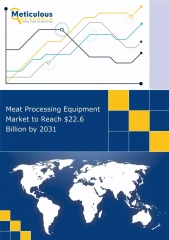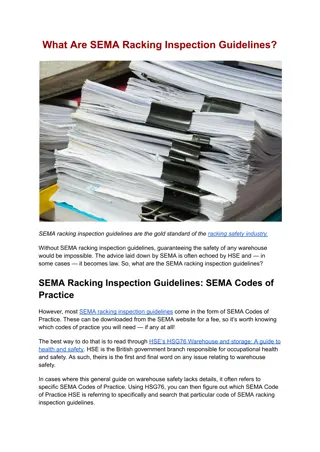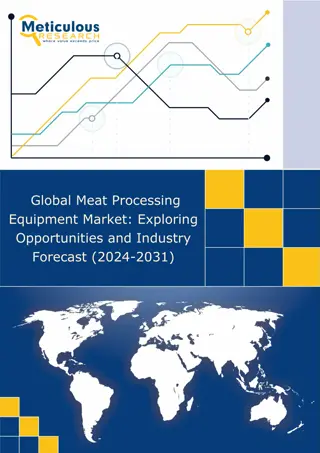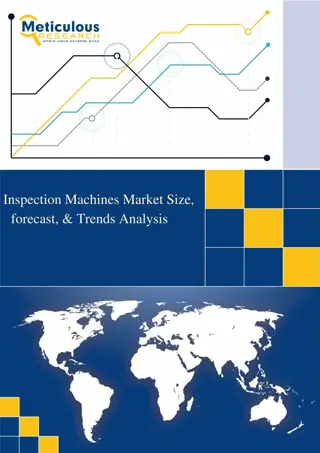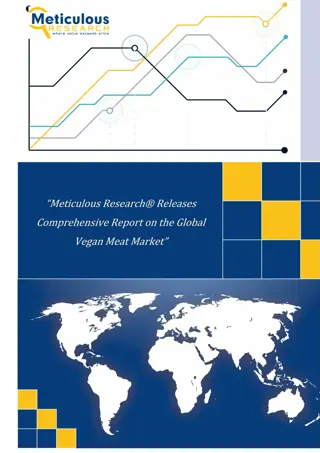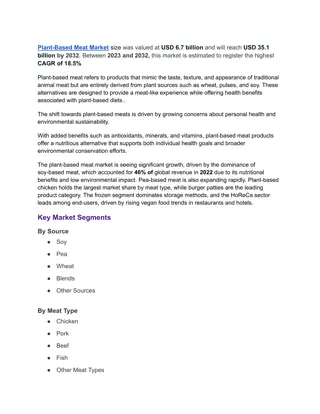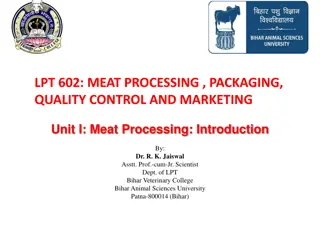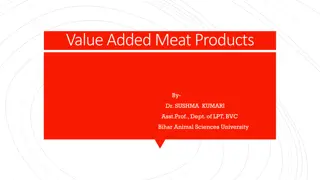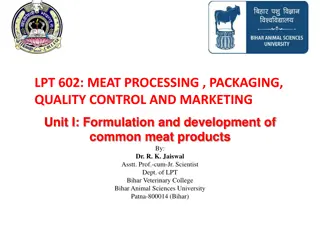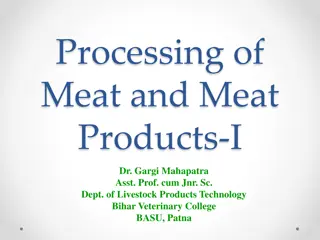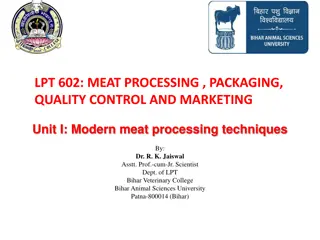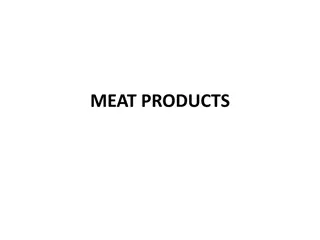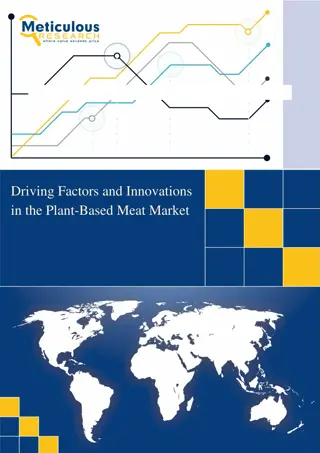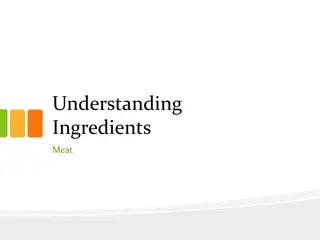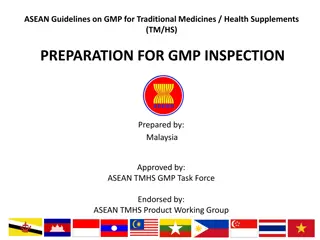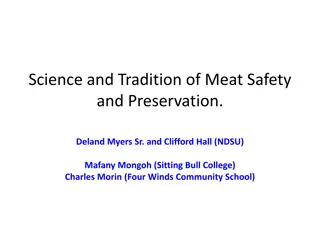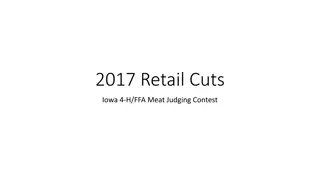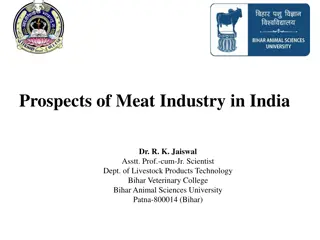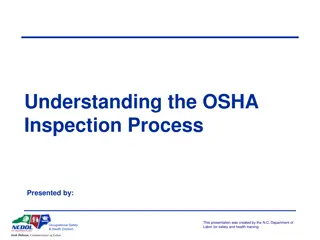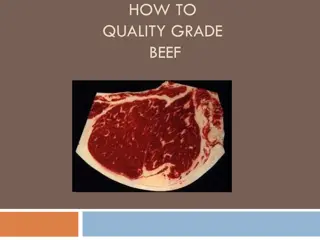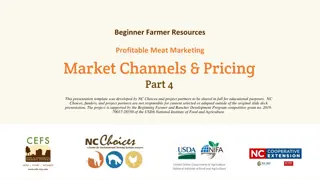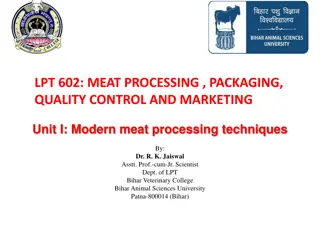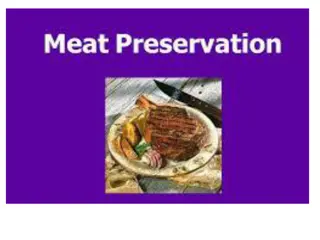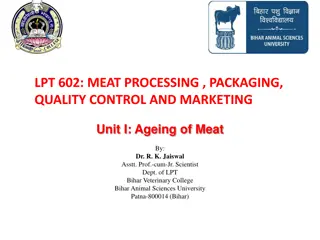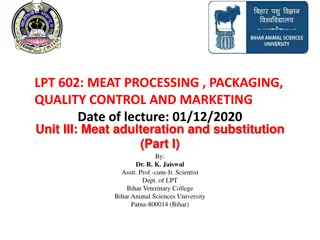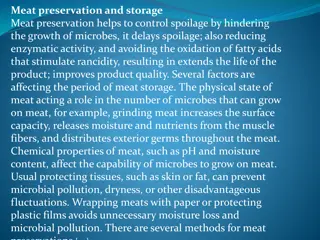Meat Processing Equipment Market to Reach $22.6 Billion by 2031
Meat Processing Equipment Market by Type (Cutters, Mixers and Blenders, Massagers, Tumblers, Tenderizers, Slicers) Mode of Operation (Semi-automatic, Automatic), Category (Processed Meat, Fresh Meat), Meat Type (Beef, Chicken) - Global Forecast to 2031
2 views • 4 slides
Inspection Machines Market Growth, Trends, Size, Revenue, Share, Challenges
Inspection Machines Market by Offering (Hardware, Software), Automation Mode (Automatic Inspection, Semi-automatic Inspection, Manual Inspection), End User (Pharmaceutical and Biotech, Food and Beverages), and Geography - Global Forecast to 2030
1 views • 3 slides
What Are SEMA Racking Inspection Guidelines?
SEMA racking inspection guidelines are the gold standard of the racking safety industry.\n\nWithout SEMA racking inspection guidelines, guaranteeing the safety of any warehouse would be impossible. The advice laid down by SEMA is often echoed by HSE and \u2014 in some cases \u2014 it becomes law. So
1 views • 2 slides
Do I need an inspection by a SEMA Approved Rack Inspector?
HSE recommends that British warehouses receive an annual racking inspection from a SEMA approved racking inspector. But what counts as a warehouse in HSE\u2019s eyes? Does your business need a an inspection by a SEMA Approved rack inspector?\n\n\/\/seerackinginspections.co.uk\/do-i-need-a-sema-appro
1 views • 3 slides
Racking Inspection Frequency & Cemetery Inspections
With so much health and safety law dependent on inspections, defining it legally can literally be a matter of life and death.\n\nAn enormous part of warehouse safety is racking inspection frequency, which HSE spells out in HSG76 \u2014 Warehousing and Storage: A Guide to Health and Safety.\n\n\/\/se
4 views • 3 slides
Meat Processing Equipment Market - Global Opportunity Analysis and Industry Forecast (2024-2031)
Meticulous Research\u00ae\u2014a leading global market research company, published a research report titled, \u2018Meat Processing Equipment Market by Type (Cutters, Mixers and Blenders, Massagers, Tumblers, Tenderizers, Slicers) Mode of Operation (Semi-automatic, Automatic), Category (Processed Mea
8 views • 3 slides
EHSA System Inspection and Audit Guide
The EHSA System Inspection and Audit Guide provides detailed information on responding to inspection findings in EH&S lab safety audits. It includes instructions on accessing audit results, responding to findings, and navigating the Safety Inspections module within the EHSA system. The guide outline
1 views • 11 slides
inspection machine
The inspection machines market is witnessing strong growth, with key players actively investing in research and development to enhance their product offerings and market presence. Technological advancements in the industry include the integration of inspection systems such as weighing machines, meta
1 views • 4 slides
Meticulous Research® Releases Comprehensive Report on the Global Vegan Meat Market
Vegan Meat Market Size, Share, Forecast, & Trends Analysis by Product (Burger Patties, Meat Balls, Sausages), Source (Soy), Meat Type (Chicken, Beef, Fish), Storage Category (Frozen), Distribution Channel (B2B, B2C {Modern Groceries}) - Global Foreca
1 views • 4 slides
Plant-Based Meat Market Strengthens with Rising Flexitarian Diets
Plant-Based Meat Market by Source (Soy, Pea, Wheat, Blends, And Other Sources), By Meat Type (Chicken, Pork, Beef, Fish, and Other Meat Types), By Product Type (Burgers, Patties, Sausages, Other Product Types), By End-User, By Region and Companies -
2 views • 4 slides
Understanding Meat Processing: From Ancient Techniques to Modern Innovations
Meat processing involves various methods such as curing, smoking, canning, cooking, and more to alter fresh meat for consumption. The practice has evolved from ancient civilizations like the Egyptians and Romans to modern times, focusing on improving shelf life, flavor, and nutritional value of meat
2 views • 10 slides
Innovative Value-Added Meat Products by Dr. Sushma Kumari
Enrobing and incorporating seasonal vegetables in meat products, restructuring less valuable meat, and creating various meat products like ham, bacon, sausages, and more are methods used to enhance the quality, flavor, and healthfulness of meat products, as outlined by Dr. Sushma Kumari, Assistant P
0 views • 13 slides
Meat Processing and Product Formulation
Explore the formulation and development of common meat products such as meat balls, patties, and pickles. Learn about the ingredients, ratios, preparation methods, and packaging techniques involved in creating these popular meat items.
2 views • 13 slides
Understanding Meat Processing Techniques and Procedures
This article discusses the processing of meat and meat products, including basic and advanced procedures such as comminution, emulsification, and curing. It delves into the importance of size reduction, emulsions, and stable meat emulsions in enhancing the quality and characteristics of meat product
0 views • 21 slides
Modern Meat Processing Techniques: Comminution and Beyond
Explore modern meat processing techniques such as mincing, milling, and chopping for the comminution of meat, resulting in improved texture and quality of meat products. Learn how uniformity in size, breaking up connective tissues, and binding lean meat with fat enhance the appeal and desirability o
0 views • 11 slides
Importance of Meat Hygiene and Sanitation in the Meat Industry
Meat hygiene is essential to ensure the safety and suitability of meat for consumers. It involves implementing specific standards and regulatory actions to maintain cleanliness and prevent contamination at all stages of production. Proper cleaning and sanitization practices, adherence to legal stand
0 views • 16 slides
United States Food Safety and Inspection Service: Ensuring Meat and Poultry Products' Safety
The United States Department of Agriculture's Food Safety and Inspection Service (FSIS) oversees the federal inspection of meat and poultry products to ensure their safety for human consumption. The statutes governing this process include the Federal Meat Inspection Act, the Poultry Products Inspect
0 views • 23 slides
Understanding the Spoilage Flora in Raw Meat Products
Raw meat products are highly perishable due to the presence of various spoilage bacteria, yeasts, and molds. Factors such as nutrient availability, oxygen levels, storage temperature, and pH influence the predominant spoilage flora in meat. Psychrotrophic bacteria thrive in refrigerated storage, lea
0 views • 17 slides
Opportunities for Scaling up Bovine Meat Exports in Pakistan
Pakistan's bovine meat export sector has potential for growth, with a focus on chilled bovine meat. The country currently holds a limited share in the global market, exporting mainly to GCC countries, Afghanistan, and Vietnam. Within the GCC market, Pakistan has significant market share in both chil
0 views • 21 slides
Plant based meat market 4
The changing lifestyles and an increasing number of health-conscious consumers are increasing the popularity of plant-based meat products, positively impacting the demand for plant-based meat. The growth of the plant-based meat market is mainly attri
1 views • 4 slides
Case Study of Human Trichinosis in Texas Region
Human trichinosis is a parasitic disease caused by consuming undercooked or raw meat infected with Trichinella larvae. This case study details the presentation, diagnosis, and treatment of a 36-year-old female physician from San Angelo, Texas, who manifested symptoms after consuming bear meat from A
0 views • 22 slides
Understanding Different Types of Meat and Poultry
This informative content delves into the world of meat and poultry, discussing various types, structures, nutritive value, and uses. From red and white meat to game animals, it covers the diversity of options available in markets and highlights processed products like canned meat and sausages. Learn
0 views • 34 slides
ASEAN Guidelines on GMP for Traditional Medicines/Health Supplements - Preparation for Inspection
This content provides guidelines on preparing for a Good Manufacturing Practice (GMP) inspection for traditional medicines and health supplements in ASEAN countries. It covers activities such as planning inspections, forming inspection teams, reviewing documentation, preparing inspection plans, hold
0 views • 19 slides
Exploration of Meat Preservation Techniques from Various Cultures
This project delves into the science and tradition of meat safety and preservation, focusing on beef jerky as a counterpart to traditional Native American dried meats. It includes activities like preparing jerky, evaluating salt's impact on preservation, and sensory testing. Additionally, it explore
0 views • 23 slides
2017 Retail Cuts Iowa 4-H/FFA Meat Judging Contest - Image Gallery
Showcasing a collection of images from the 2017 Retail Cuts Iowa 4-H/FFA Meat Judging Contest, this gallery provides visual insights into the competition. The images capture various aspects of the contest, offering a glimpse into the world of meat judging in Iowa. From different cuts of meat to the
0 views • 32 slides
Understanding Meat Grading and Quality Certification
Explore the process of meat grading and certification, including the establishment of USDA standards, mandatory inspection for wholesomeness, voluntary grading for quality, and the determination of quality grades based on factors like tenderness, juiciness, flavor, and marbling. Learn how age and ma
0 views • 15 slides
Overview of Meat Industry Prospects in India
The meat industry in India holds significant prospects with a large livestock population, ranking high in goat, buffalo, sheep, and cattle numbers globally. The country has seen developments in modern abattoirs and meat production statistics. Animal food is noted for its high-quality nutrients compa
0 views • 21 slides
Understanding the Importance of Flavor in Meat Science
Flavor plays a crucial role in meat quality perception, with tenderness and juiciness following closely behind. Consumers prioritize specifically cooked meat flavor for acceptance. Understanding flavor compounds and the difference between taste and flavor is vital in meat palatability. The five basi
0 views • 22 slides
Understanding OSHA Inspection Process: Safety Training Overview
This presentation, created by the N.C. Department of Labor, delves into the OSHA inspection process. It covers various inspection types, procedures, rights and responsibilities of employers and employees, and post-inspection processes. Key topics include amputations, inspection priorities, special e
0 views • 23 slides
Understanding Quality Grades of Meat
Quality grades of beef are based on factors like marbling, tenderness, and age of the animal. Grades range from Prime to Cutter, influencing the meat's flavor and juiciness. Lamb and poultry also have quality grades, while pork is not graded by the USDA due to its consistent tenderness. Assessing ma
0 views • 33 slides
Beginner Farmer Meat Marketing Analysis & Strategies
Explore pricing strategies, market channels, and financial goals for beginner farmers in profitable meat marketing. Learn to identify desired profit, determine pricing per channel, and select viable sales avenues. Analyze market observations and plan sales projections for different meat types. Disco
0 views • 19 slides
Modern Meat Processing Techniques: Comminution, Milling, Chopping
The modern meat processing techniques involve comminution of meat cuts to enhance texture and quality. Mincing, milling, and chopping are key processes that help in achieving uniformity, texture, and binding of meat products. Different technologies such as meat mincers, millers, and choppers are uti
0 views • 11 slides
Supplier Briefing Pack for Inspection Processes
Inspection processes are crucial steps in ensuring product quality and compliance with specifications. This briefing pack covers general requirements, visual inspection, dimensional inspection, non-destructive testing, calibration, control and measuring equipment, and inspection records. Emphasis is
0 views • 10 slides
Component Design Basis Inspection (CDBI) Program Overview
The Component Design Basis Inspection (CDBI) program ensures plant components are maintained within their design basis and monitors their capability to perform essential functions. Insights reveal the inspection frequency, estimated hours, fees, team composition, and inspection schedule. The baselin
0 views • 18 slides
Improving Real Estate Assessment Center (REAC) Inspections: National Standards for the Physical Inspection of Real Estate (NSPIRE) Overview
The National Standards for the Physical Inspection of Real Estate (NSPIRE) aims to address the shortcomings in current inspection models for HUD and HUD-assisted properties. The Inspection Task Force is reexamining REAC inspections to focus on health and safety hazards, year-round maintenance practi
0 views • 19 slides
Methods of Meat Preservation and Drying Techniques
Meat preservation is crucial to prevent microbial spoilage during distribution and storage. Methods include physical (drying, refrigeration, heat) and chemical (salting, smoking) techniques. Drying meat reduces water content, inhibiting microbial growth while prolonging shelf life. Various drying me
0 views • 33 slides
Understanding the Ageing Process of Meat in Meat Processing
Ageing of meat is a crucial process in meat processing that involves holding unprocessed meat at specific temperatures to enhance tenderness and flavor. This process, also known as ripening or conditioning, triggers physical and chemical changes in protein structure, collagen, and proteolysis. Diffe
0 views • 11 slides
Level II Inspection Overview
Level II inspection involves specialized knowledge and equipment for detailed assessments of bridge components. It includes various inspection types like CSE testing, concrete deck inspection, underwater inspection, and more. The process follows specific forms for bridges and culverts, emphasizing t
0 views • 19 slides
Understanding Meat Adulteration and Substitution in Food Processing
In meat processing, there is a risk of substituting lower quality meats for higher quality ones to deceive consumers. Differentiating between animal meats is crucial, especially in minced or sausage forms. Horseflesh, with its high glycogen content, presents a unique challenge. Methods for meat spec
0 views • 7 slides
Meat Preservation Techniques and Storage Methods
Preserving meat is essential to control spoilage and extend its shelf life. Factors like temperature, pH, moisture content, and packaging play crucial roles in meat storage. Methods such as chilling, freezing, curing, smoking, canning, and drying are commonly used to preserve meat, each offering uni
0 views • 8 slides
